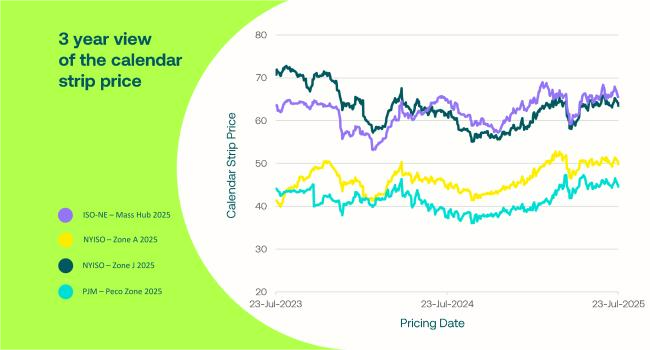UEC Insights: July 24, 2025
Market Update
Natural gas prices declined this past week. Prompt month is currently at $3.13/MMBtu, down $0.45. With plenty of volatility, the market is leaning bearish. Weather continues to be key, with hot temps across 80% of the country.
Storage remains strong, at 3.052 Bcf in storage - 3.2% above the 5-year average. This week’s expectation is for a build in the low 30s. Storage could reach near-max levels in the low 4 Tcf by the end of injection season. Production is trending near recent highs, averaging 106.5 Bcf/day, touching 107 Bcf/day. For power, cash spiked in the $200-$400/MWh in some regions. These price surges reflect tightening supply-demand balances and short-term weather-driven demand spikes.
The PJM capacity results are in for PY 26/27. Prices cleared at $329.17/MW Day and 22% above the current rate. Peak load came in 4,000 MW higher than forecast, contributing to the bullish result. A combination of an increase in demand forecasts and the potential generation retirements plated a key role in tightening capacity.
While energy prices are still elevated, make-whole payments to generators - which help cover their operational costs when market revenues fall short - have reached an all-time high, adding to the cost burden in power prices.
PJM Capacity Prices Hit Cap Again Amid Tight Supply and Rising Demand
PJM Interconnection’s latest Base Residual Auction for the 2026/2027 delivery year cleared at $329.17/MW-day - matching the Federal Energy Regulatory Commission-approved price cap and marking the second consecutive year of record-high results. The sharp price increase from $269.92/MW-day in the prior auction reflects tightening supply, increased peak demand, and recent rule changes.
PJM noted a 5,400 MW year-over-year rise in forecasted peak load, largely driven by data center growth, electrification, and overall economic expansion. Despite a compressed auction timeline, this year’s results indicate supply is responding to the investment signals from last year’s high prices, with 2,669 MW of new or uprated generation capacity clearing - ending a four-auction streak of flat growth.
Notably, this auction cleared just 139 MW above PJM’s reliability target, signaling a delicate supply-demand balance across the region. All zones cleared at the same price, underscoring how widespread the constraints are.
Recent changes, including the expanded must-offer requirement for all resource types, also played a key role in shaping the results. PJM’s capacity mix for this period includes 45% gas, 22% coal, 21% nuclear, and smaller shares of hydropower, wind, and solar.
As PJM prepares for the 2027/2028 auction in December, it continues working toward resuming a consistent three-year-ahead planning schedule. Industry stakeholder will be watching closely to see how ongoing reforms and market conditions shape future pricing.
High Costs and Grid Constraints Slow Data Center Growth in New England
Despite rising national demand for AI-driven data processing, data center growth in New England remains limited in 2024, the regions data centers used just 317 MW of power, highlighting slower development compared to the other parts of the U.S.
High electricity prices and limited land availability are key obstacles to growth. New England’s reliance on imported natural gas contributes to price volatility, creating uncertainty for developers seeking affordable, reliable power.
Although state lawmakers have introduced legislation to attract investments, such as long-term tax incentives and equipment sales tax exemptions, resource adequacy concerns remain a significant barrier, industry experts emphasize the need for data center developers to secure their own generation sources to avoid additional strain on the grid.
Many projects remain in early planning stages due to interconnection challenges and delays in system studies. As large-scale development proves difficult, the region may see modest growth in smaller-scale data centers serving industries like biotech, pharmaceuticals, and finance.
To position New England as a viable destination for data center expansion, experts urge a combination of forward-thinking policy, infrastructure investment, and incentives that support sustainable, self-powered growth. Without these steps, the region risks falling further behind in the race to support the digital economy.

